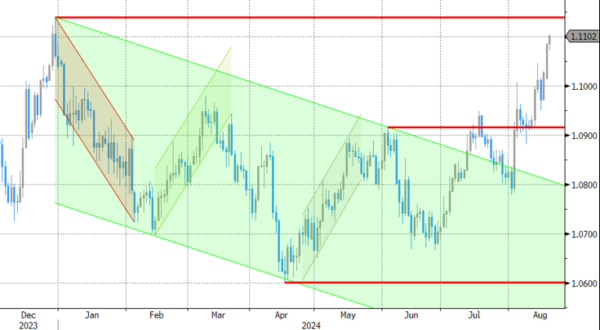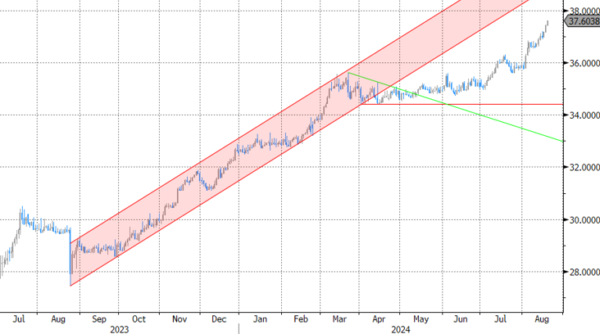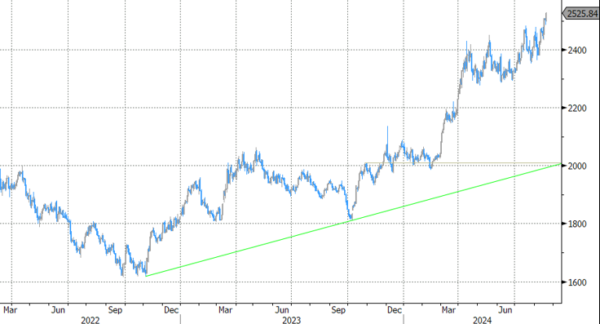Markets
Markets took a breather today during the European session. The dollar (DXY) yesterday closed below 102 for the first time since early January and remains stuck there. The greenback even extends losses as US investors enter the market. European stock markets tread water after completely recovering from the early August meltdown. The same reasoning goes for US stock markets. Core bond yield, if any, slip further away with US Treasuries outperforming German Bunds. The waiting game ends tomorrow with the preliminary annual payrolls benchmark revision by the Bureau of Labour Statistics. Once a year, the BLS benchmarks the March payrolls level to the Quarterly Census of Employment and Wages which is based on state unemployment insurance tax records and covers nearly all US jobs. The QCEW was released back in June and suggested that US job growth in the year through March was likely less robust than indicated. Ballpark figures suggest a downward revision of about 60k/month on average. Some forecasts even go as wild as near 100k/month. In the 12 months through March, net job growth averaged 242k. One of the reasons why the BLS over the past year systematically overstated job growth has to do with the “birth-death model” of businesses they use to adjust data for the net number of businesses opening and closing. This doesn’t correlate that well with reality in the post-pandemic world. Anyway, tomorrow’s payrolls revision had over the past months been flagged as a potential gamechanger pushing markets and the Fed away from “higher for longer” into more outspoken rate cuts. The revision could suggest that the US labour market already tipped somewhere in H2 2023. With inflation printing more benign and making the real policy rate more restrictive, the Fed has more room to act to the second pillar of its dual mandate: aiming for maximum employment. Since the early August repositioning in US money markets, the BLS update likely lost market impact. From being a potential game changer to more of a confirmation. Nevertheless, any substantial (>50k/month) downward revision won’t go unnoticed and could tip markets more in the direction of a 50 bps rate cut lift-off at the September 18 FOMC meeting. Minutes of the July meeting (to be released tomorrow as well) could offer some counterweight to this aggressive market thinking. So far, Fed governors hinted at a 25 bps – if any at all – move with gradualism being the magic word.
News & Views
The Swedish Riksbank cut its policy rate again by 25 bps, to 3.5%, continuing the easing cycle it started in May. The RB sees inflation in the process of stabilizing at the target (CPIF inflation 1.7% Y/Y in July, core CPIF 2.2% Y/Y) while activity remains weak. Looking forward, indicators such as producer prices and company pricing plans, have continued to imply that inflationary pressures are compatible with the target. The risk of inflation becoming too high again has declined significantly. Information since the June Monetary Policy Report indicates that the growth outlook in Sweden and abroad is somewhat weaker than expected. In light of this, the RB assesses that the policy rate can be cut somewhat faster than indicated in June. If the inflation outlook remains the same, the policy rate can still be cut two or three more times this year. The RB mentions a weak koruna as a risk factor for inflation, but for now it isn’t a prohibitive factor to step up the pace of easing. The reaction on Swedish interest rate markets was limited (2-y swap 2.33%, +1.5 bps) as markets already discounted the RB policy rate near 2.75% at the end of the year. EUR/SEK even declined slightly to test the 11.40/38 support area as easing global market conditions currently support smaller currencies like the krone despite reduced interest rate support.
The Central Bank of Turkey (CBRT) kept its policy rate unchanged at 50% for the fifth consecutive month. The underlying trend of monthly inflation rose slightly in July but remained below its Q2 average (July headline inflation 3.23% M/M and 61.78M Y/Y). Q3 indicators suggest that domestic demand continues to slow down with a diminishing inflationary impact. While goods inflation is declining, improvement in services inflation is expected to lag. The Committee emphasized that the alignment of inflation expectations and pricing behavior with projections has gained relative importance for the disinflation process. Earlier this month, the CBRT kept its inflation forecasts for end-2024 and -2025 at 38% and 14% respectively. Analyst forecast see chances of the CBRT gradually reducing the policy rate in Q4. The lira weakens further today to trade at a new all-time low against the euro (EUR/TRY 37.60).
Graphs
EUR/SEK: krone loses interest rate support, but easing global conditions have bigger impact
EUR/USD: dollar weakness still prevails in run-up to this week’s big events, starting with BLS payrolls revision tomorrow
EUR/TRY: not even a 50% policy rate can stop the rot in the Turkish lira
Gold: new all-time high as markets bet on aggressive Fed rate cuts to save the day

















